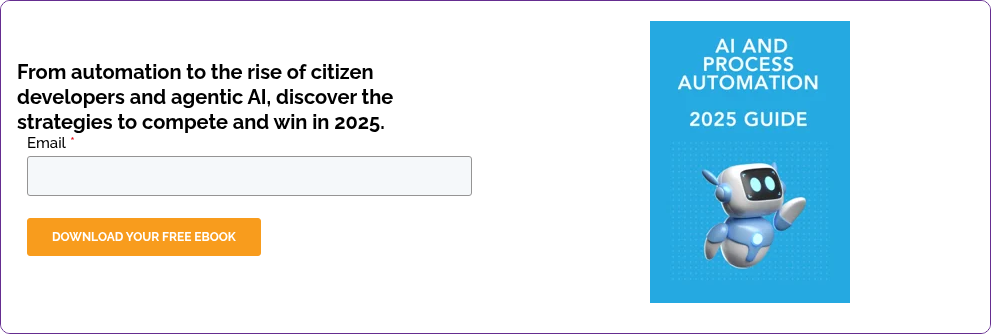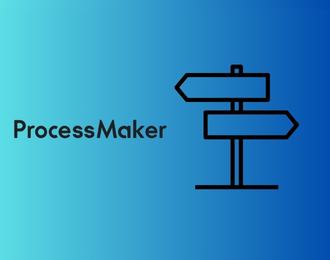Challenges of Process Automation
1. Data Audit
The first challenge you may face when you kickstart your process automation project is data. You'll need to know where your data is currently kept, who has ownership of the data and any possible issues with the data integrity.
Data contained in emails, spreadsheets or paper risks causing poor data quality, inaccurate reporting and security threats. The time spent managing data through manual business processes is also unproductive and takes workers' time away from focusing on value-added tasks.
2. Mapping Processes

Once you have defined where your data is located, whether through emails, paper or spreadsheets, you'll need to start mapping your data collection and reporting process. Start with simple business processes and begin mapping the steps across the process.
3. Integrations

Business processes can take across multiple systems and involve multiple internal and external stakeholders. Your process mapping should identify the technologies and people involved in your business process. Integrations are key for centralizing the data included in your processes and hoisting one source of truth for the data so that your reporting is accurate.
At FlowForma, our platform integrates with thousands of other systems to ensure a seamless digital experience with process automation.
4. Process Automation Analytics
Having robust data analytics is a key challenge for every process automation project. Analytics provides valuable insights into your business processes, business data and project progress.
But analytics is just one part of the process. Analytics need to be reviewed in digestible format so that leaders can make informed decisions. That's where visually rich dashboards are needed to bring data to life so that analysts can understand the importance of data within key areas.
At FlowForma, we provide analytics and dashboards that are seamlessly integrated with our platform. Learn more in the video:
5. Choosing The Right Business Process Automation Platform
Another key challenge with business process automation is finding a tool to support your journey. Having worked in IT for over 20 years, I have found the following framework useful when sourcing a process automation platform.
Write a technology requirements brief
The technology brief is the starting point for every process automation project. You'll need to include a detailed requirements document that outlines:
-
The goals and key performance indicators of your process automation project
-
Resources required
-
Set up a working group to manage the project
-
Identify digital champions that can support the project
-
Meeting cadence during the project
-
Budget allocated for the project
-
Timeline for the project
Process automation vendor selection
Once you have a brief formulated, the next step is to shortlist business process automation vendors. Some leading vendors in the space include Power Apps and Power Automate, Kissflow and FlowForma Process Automation.
When shortlisting a technology vendor to support your process automation I recommend:
Comparing costs
Think about your current usage and how the pricing scales when you increase user count in the future. While entry-level pricing might seem low, costs quickly scale when you introduce new users to the platform.
Think about your requirements
Some process automation platforms are 100% no code while others are low code. No code platforms are better suited to organizations that want non-IT workers to automate processes. While low-code tools require workers with coding skills.
Reference customers
Does the platform have a proven track record of automating processes in your vertical? Speaking with reference customers will help you understand if the platform is the right fit for your business process automation needs.
Does the platform provide onboarding
Onboarding is a key step in the successful implementation of every technology solution. But, not all platforms provide onboarding. Make sure to have onboarding as part of your shortlist matrics checklist.
How steep is the learning curve
This is a key question to ask and will have a direct impact on your project timeline and whether the platform will be used widely throughout your organization. As mentioned earlier, a no code platform is recommended if you intend for non-IT users to operate the platform. However, if we want to limit the platform to IT use only, a low-code platform is recommended.
Product roadmap
Does the business process automation tool have a product roadmap that aligns with your business growth? With the advent of artificial intelligence (AI), business process automation will be further transformed with new exciting features and functionality. Learn more about the future of artificial intelligence (AI) and business process automation in our recent blog here.
Benefits of Process Automation
Benefits can be gained by organizations and individuals. At an organizational level, process automation improves efficiency and customer experience while reducing business risk. Automation increases accuracy at every process step, ensuring business goals are achieved efficiently with minimal overruns and re-work.
At a personal level, process automation improves resource productivity by assisting employees to achieve their objectives and increases employee and customer satisfaction. Let's dig a bit deeper into each benefit.
Improved efficiency
Process automation empowers workers to work faster, smarter and more efficiently. Transitioning from manual processes to digital processes, streamlines tasks and therefore reduces the time needed to complete the process.
One example of improved business efficiency worth mentioning is with a financial services company called Grant Thornton.

Grant Thornton automated its HR processes using FlowForma Process Automation and achieved a 60% productivity improvement. Learn more about this case study here.
Reducing risk
In the digital age, technology plays a central role in mitigating compliance, health and safety risks. Process automation can help organizations stay compliant with the accurate collection of data, reporting of data and sharing of the data with internal and external stakeholders.
Reduce new hire need
According to Delloite, Talent remains a top concern for CEOs, with 71% of CEOs citing global labour/skills shortage as their top external challenge. Implementing process automation will improve productivity in your workforce, freeing up time to focus on more value-added work. In essence, your teams will be empowered to do more, without the additional human capital
Improve data for business processes
A process automation tool will centralize key business data, streamline processes and provide visibility for informed decision-making. Improved data quality will help improve business decision-making with access to data in real-time.
Process Automation Examples
Automation can be applied to any process, but the most beneficial areas in any business are those that:
Require vigor
For example, CAPEX requests must have a certain set of accurate information collected before purchase orders are raised. Automation can ensure that all the data is present and correct before submitting for approval.
Require consensus
Project changes must be documented, and risk assessed before being approved and scheduled for completion. An automated system can push change information to authorized individuals and seek their comments and approval.
Require compliance
Providing a true audit record of the regulatory authority of both the process definition and every process execution. This can be very difficult to achieve without an electronic process automation solution that records an audit record of all process activity.
Require collaboration
Where teams are dispersed over large geographic areas, or collaborating between different organizations, when you automate business processes you can speed up communications and provide the necessary information for each resource to complete their task.

This depends on the process automation solution and the complexity of the process. The best solution is one where you can prototype automated processes to quickly validate them in a real working environment. This helps you to overcome one of the biggest automation challenges, the management of change.
Introducing process automation provides many benefits, but those benefits are only realized when the automation solution is adopted. So the best way is to work quickly with flexibility, to ensure that the time to value for your automation efforts is kept to a minimum. Simple processes, or those based on pre-built templates, can be deployed in weeks using the best process automation solutions.
Importance of Process Automation
To match or exceed the performance of your competitors as process automation is being widely adopted, to a greater or lesser extent.
The cost and time frame of deployment of automated processes in your environment is critical to giving your organization that competitive edge that wins more business through better customer service and generates more profit that can be re-invested to strengthen your offering to the market.
How to Implement Process Automation
Process automation provides benefits in efficiency and service improvement as soon as it is deployed and adopted in an organization. ‘Time to deployment’ is critical to the overall success of any automation solution.
It is always advisable to start with a strategy for deploying processes and look to deploy your first automated processes within the first month after acquiring an automation platform. Select the areas or the business that will see the most benefit, implement quickly and generate momentum.
Process automation solutions provide metrics on how well the processes are performing so that you can easily see the impact of automation on the business.
Conclusion
Process automation plays a vital part of the success of organizations in the digital age. While there are challenges to process automation, partnering with a vendor that can support your journey is critical to achieving your goals.
To learn more about process automation as a driver for digital transformation, why not download our recent guide, 6 Steps to Process Automation Success.
If you're ready to accelerate your process automation journey, speak with our team today and get a live demo of FlowForma Process Automation.
.png) By
By 





